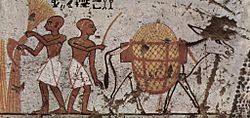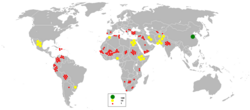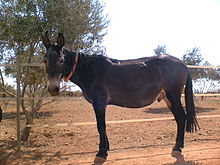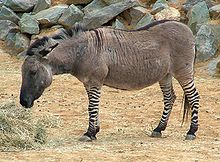Equus africanus asinus
The donkey, donkey, jumento, donkey, reizor or colt (Equus africanus asinus) is a domestic animal of the family Equidae. The wild African ancestors of donkeys were first domesticated in the early 7th millennium BC. C., two centuries before the horses of Eurasia, and since then they have been used by humans as pack animals and as horses. The appearance of agricultural machinery has led to a considerable decline in their populations.
Etymology
The word «ass» comes from the term that designates this animal in Latin: asinus, and which is also used in its scientific name to designate the domestic subspecies. The terms, also Latin, that designate its genus and species, Equus africanus, literally mean "African horse".
The words "donkey" or "borrico" are derived from the Late Latin burricus, which meant "little horse", while caballus was a gelding used for pulling or load. Since the 1st century, although asinus continued to be the name of the species and of the stud donkey for procreation, the common working donkey was normally given the Latin name asellus.
Taxonomy
Domestic donkeys were originally classified as one species, Equus asinus, and this classification was maintained for a long time. When it was shown that the domestic and wild African donkeys, Equus africanus, belonged to the same species, they had to have the same scientific name. Generally, in cases like this, the principle of priority used in scientific nomenclature would be applied, which establishes that the first to have been registered must remain as the specific name, with asinus being the oldest. But the International Commission on Zoological Nomenclature determined in 2003 in Opinion 2027 that domestic asses, like seventeen other domesticated species, should be named after their wild variety, Equus africanus, and therefore donkeys domestics were to be named as the subspecies Equus africanus asinus. This decision was made to avoid the paradox that earlier lineages, the wild ones, were named as subspecies of their descendants.
Donkeys are classified within the order Perissodactyls, belonging to the Equidae family, to which also belong the horse (Equus ferus caballus), the onager or the kulán (Equus hemionus), the kiang (Equus kiang) and the zebras, all of which are closely related by belonging entirely to the sole surviving genus, Equus.
Description
They vary considerably in size. Most domestic donkeys have a size that ranges between 0.90 and 1.40 m to the withers, although there are larger varieties such as the Andalusian-Cordobese and Zamorano-Leonesa breeds (which can exceed 1.60 m), and the mammoth donkey (whose largest individual reached 1.73 m) or the Catalan donkey (which reaches 1.65 m). The coloration and length of their hair is also very variable. Its most common color is gray in all its shades, reaching white and black, and brown tones are also common. They often have lighter-toned or white fur around the muzzle, around the eyes, and on the belly, and often have two dark cross-shaped stripes on their backs. Their manes are shorter than a horse's, so they stay ruffled instead of falling over the neck.
They live longer than horses, living up to forty years. They reach sexual maturity between two and two and a half years. Mating can occur at any time of the year, although it usually occurs during the spring. Gestation lasts between twelve and fourteen months, and will normally produce a single calf, rarely two, which will be weaned when it is six to nine months old.
Donkeys have adapted to living on the fringes of deserts, and as a result have characteristics unique among equids. Wild donkeys live apart from each other unlike horses and zebras, which live in herds. Donkeys are capable of braying at a very high volume that allows them to keep in touch at distances of up to three kilometers. Their long ears serve them both to better perceive sounds and to better dissipate their body heat.
They defend themselves by kicking hard with their hind legs, something that domestic animals continue to do when they are bothered, and they can also strike with their front legs and bite.
Food
Donkeys have a resilient digestive system, less prone to colic than horses, which allows them to consume a greater diversity of plants and extract water from feed very efficiently. On average donkeys need less feed than horses of equivalent size and weight; all of this allows them to live in areas that are inaccessible to their more demanding nutritional relatives.
Its diet consists of grasses, alfalfa, shrubs, and varieties of desert plants. This represents a very fiber-rich herbivorous diet.
History
The ancestors of domestic donkeys are the Nubian and Somali subspecies of African wild asses. Wild asses were domesticated around 7000 BC. Donkeys became important pack animals for people living in the regions of Egypt and Nubia, being able to carry 20–30% of their body weight, and were also used for plowing. and to be milked. By 1800 B.C. C. donkeys had already spread to the Middle and Near East, where the commercial city of Damascus is called the "city of donkeys" in cuneiform texts.
The ancient Greeks associated donkeys with the god Dionysus. The Romans also used donkeys as pack animals throughout their empire and it was also consecrated to Priapus, due to the dimensions of its phallus, to whom it was offered as a sacrifice, because according to legend this god had killed one on Bacchus' expedition to the Indies for having had the insolence to dispute the prize of strength.
Equids had become extinct in the Americas at the end of the last ice age. Horses and donkeys were introduced to the Americas by the Spanish conquistadors. The first appearance of the donkey in the New World occurred in 1495, when Columbus took four males and two females on his expedition. Subsequently, European settlers imported donkeys of various varieties from both Spain and France, mainly with the purpose of being used to produce mules. In addition to their traditional use in agriculture and transportation, donkeys were used in mining from the 19th century.
With the advent of modern farm machinery and transportation, donkeys have been used less and less since the early 20th century in wealthy countries, although they began to be used for tourism and as pets, and continue to be used as working animals in developing countries. Miniature breeds are the most appreciated as pets.
Mythology and symbology
The donkey was an animal consecrated to Priapus and offered to him as a sacrifice since this god killed one on Bacchus's expedition to the Indies for having had the audacity to dispute the prize of strength. He was admitted to the mysteries of Vesta as a reward for having discovered this goddess with her braying the violence that Priapus tried to do to her while she slept.
The Egyptians considered the donkey a symbol of Typhon and traced its figure on the cakes they offered to this god of evil. The donkey was very badly treated in Coptos. The inhabitants of Busiris, Abydos and Lycopolis played the trumpet imitating the braying of the donkey. Among the Egyptians ignorance was represented with a head of this animal. When they wanted to designate a work of short duration, they figured a donkey at a great gallop because when it gallops, it is only for an instant, returning to its natural pace very soon.
The Romans retained much of this aversion against donkeys and meeting one was considered a bad omen. A unique fable has been preserved in which the donkey plays a rather important role. After Jupiter had taken possession of the empire of the world and mortals flocked to offer incense on their altars, moved by the god of his mercy, he promised to attend to the desire that they formed. Men asked for the gift of eternal youth without ever passing into the sad state of old age. Jupiter commissioned the donkey to carry this invaluable gift, but feeling fatigued he approached a fountain to cool off. The snake that guarded it gave the donkey to understand that in order to drink, it was necessary that it first give up the treasure that he was carrying. The stupid animal had no difficulty exchanging a liquor more precious than nectar for a few sips of water. Since then snakes have had the privilege of shedding their skin and regaining all the freshness and vigor of youth, while mortals are subject to old age and death as before.
Economic use
According to Galen, Maecenas was the first to use the meat of this animal among the Romans. The Persians have eaten this meat preferring it to that of the gazelle, a taste that was also that of their ancestors. Oleario says that in a great feast given in 1656 by Cha-Abbas to the ambassadors, thirty-two wild asses were killed, their meat being exquisite and ordinarily reserved for the monarch's table; and he also adds that the king of Persia took pleasure in this hunting and that he sent the asses that had died to Isfahan to the kitchen of his court. Hippocrates and Galen regarded this meat as indigestible and even dangerous, which did not prevent Pliny and others from advocating its efficacy against tuberculosis, skin diseases, etc.; at least it seems to be hard and tasteless. Nevertheless, it has frequently served in times of famine, and is also said to have sometimes substituted for veal in certain localities in France; Lastly, it was the basis for Bologna sausages, sought after by those with a sweet tooth; that of the donkey, especially wild, is assured that it is much better.
Formerly, blood, gall, fat, spleen, kidneys, testicles, hair, hooves and even urine and donkey droppings were used therapeutically against a number of diseases, such as cold sores, jaundice, paralysis and epilepsy. As for the Hokiak tablets, which the Chinese call Ngo-kiaeo or Hoki-hao, which they say prepare with the skin donkey, are nothing more than highly flavored gelatin. Drums are made with this skin. The exercise of the donkey or aselación offers, with a little less activity, the same advantages as horse riding.
Since early history, donkeys have been used in Europe, Asia, and Africa to carry loads, pull carts, and move people. Despite not being as fast and strong as horses, they are less expensive to maintain, have great endurance and long life, and are more agile over rough and uneven terrain than horses. They continue to be of crucial economic importance in many developing countries.
Donkeys have long had a reputation for stubbornness, but this is due to some people's misinterpretation of their highly developed self-preservation instincts. It is difficult to force a donkey to do something that contradicts his own interests. They are intelligent, cautious, friendly, playful animals and interested in learning. Once you have earned their trust they can be good companions at work and play; for this reason they are now commonly kept as pets in some countries, where their use as pack animals has disappeared. They are also popular for walking children in some tourist and recreational places.
In prosperous countries the welfare of donkeys, both at home and abroad, has recently become a concern and some shelters for veteran donkeys have been set up.
Another application recovered from the donkey is its use as a lookout animal against wolves and wild animals. The donkey, capable of detecting the presence of predators more easily than cattle, alerts with braying their presence serving as a warning to both ranchers like the animals with which he lives; such is the case of cows, which will better protect their calves.
Donkeys are also raised to eat their meat, which is part of the gastronomy of some regions of Spain and countries like China.
Current situation
There are currently about 44,000,000 (forty-four million) donkeys. The population of these animals has grown since the middle of the XX century: from 1961 to 1980 it rose from 37,000,000 (thirty-seven million) to 40,000,000 (forty million), holding steady until rapid growth in the second half of the 1980s.
In Africa the population of this species grew from 8,500,000 to 13,700,000 between 1949 and 1997. Currently, there are 5,000,000 (five million) donkeys in Ethiopia, 1,690,000 (one million six hundred and ninety thousand) in Egypt, 1,000,000 (one million) in Nigeria, 678,000 in Sudan, 611,000 in Mali, 455,000 in Burkina Faso, 450,000 in Niger and 300,000 in Kenya.
In Latin America there are currently 7,700,000 (seven million seven hundred thousand) heads, mainly in Mexico (3,250,000), Colombia (710,000), Bolivia (720,000), Peru (520,000) and Venezuela (440,000).
In Asia there are more than 20,000,000 (twenty million) donkeys, of which there are about 11,000,000 (eleven million) in China; the rest are mostly in Pakistan (3,900,000) and India (1,600,000).
There are countries where the population has been greatly reduced until 1996, for various reasons, such as the modernization of means of transportation; examples are Iran (which went from 2,160,000 to 1,400,000 since 1976), Iraq (which went from 530,000 to 145,000 in three decades), Turkey (which decreased from 1,970,000 in 1966 to 800,000), Yemen (790,000 in 1976 to 500,000), Morocco (1,200,000 in 1976 to 880,000), South Africa (310,000 to 100,000 head in just 10 years) and Brazil (1,460,000 to 1,370,000 since 1976). Another reason for this reduction is famine, drought, poor living conditions and civil wars like the one in Afghanistan, which went from 1,325,000 head in the 1980s to 1,160,000 today.
But the most drastic reduction has been in Europe. Donkeys went from two million heads to half a million in three decades. The various native Spanish breeds are in danger of extinction, especially the Zamorano-Leonese and Catalan breeds. This has led to the appearance of initiatives for its defense, even going so far as to use it for purposes dedicated, in principle, to horses. Donkey therapy for disabled children has also begun to be developed.
The donkey in literature and popular culture
The long history of donkey use by humans means there are plenty of cultural references to it.
- In the fables of Esopo the figure of the donkey represents the role of the humble in various situations: sometimes it is believed important and the powerful put it in place as in the ass and the lion or the ass and the image, although also the humble ass gives some lesson to the powerful and the arrogant as in the ass and the wolf or the horse and the ass. It also represents the trusted companion who is betrayed by a malicious friend as in the donkey and the goat or the bitch and the donkey.
- The Romans took the meeting with an ass as an omen of calamities.
- In the story The musicians of Bremen It is the donkey who begins the group of musicians.
- The golden ass or Asinus aureus is an ingenious novel written by the Latin author Lucio Apuleyo where the famous episode of Psiquis is found.
- In the European folklore we find references to the healing power of the tail of donkey in cases of ferin cough and scorpion bites.
- The donkey has long been a symbol of ignorance. An example can be found in Dream of a summer night Shakespeare and the fable the flautist donkey Iriarte. Pinocchio is another clear example, where children who visited the "games island" became ass to leave the studios for fun and holganza. For this reason you are given the peyorative qualification donkey or ass an ignorant person or of little intelligence.
- The donkey plays or appears as a faithful companion of the protagonist in many literary works:
- In the masterpiece of Spanish literature The ingenious hydalgo Don Quixote de La ManchaSancho Panza designates his donkey as “the Rucio” or “my Rucio”, in an elegant reference to the texture of his skin.
- It's famous. Plateroof the work of Juan Ramón Jiménez Platero and me.
- In his poem The Donkey (in Spanish): The donkeyG. K. Chesterton describes people's opinion of this animal from the perspective of the donkey itself.
- In the 1945 Book Rebellion on the farm by George Orwell, the Benjamin donkey represents the intellectual class, aware of the manipulation of the Napoleon pig, but who does not participate in the criticism, stating that the donkeys live many years.
- It appears in the novel of 1953 Brighty of the Grand Canyon Marguerite Henry.
- It appears repeatedly in Christian iconography.
- Already from the birth in Bethlehem where Jesus of Newborn Nazareth is escorted by an ass and an ox according to what was said by ancient prophecies.
- During the celebration of Palm Sunday, the arrival of Jesus of Nazareth on a donkey and received by the crowd with palm leaves, whose procesional statues are popularly known in Andalusia, is commemorated. The borriquita. The flight to Egypt is also represented by a donkey loins and the donkeys are often mentioned in the Hebrew Bible. The belief that a jaw of this animal was Abel's murder weapon is, however, false. Genesis does not clarify the means used by Cain to kill his brother. It is probably due to confusion with the biblical passage where Samson ends with a Philistine army armed with a jaw of that animal.
- The ass is the animal that symbolizes the U.S. Democratic Party (against the Republican Party elephant).
- Already in the cinema and on television, there are examples of popular characters who are donkeys: Burro, franchise ShrekIgor, Winnie the Pooh, Bo de The StarAnd Little, short The Small One.
Hybrids
A donkey can impregnate a mare; its offspring is called a mule or mule. A horse can be crossed with a donkey, in this case the offspring is called a hinnies. Both hybrids are almost always sterile because donkeys have sixty-two chromosomes while horses have sixty-four, so the offspring have an odd number of sixty-three, making it difficult to form functional gametes.
Historically, it has been preferred to breed more mules than hinnies, because as the mares are larger than the donkeys, their offspring are older and stronger.
Mules are strong and resistant, which is why since ancient times humans have considered them especially useful for carrying heavy loads over long distances and in mountainous terrain. This characteristic, which makes crossbred offspring more resistant than their parents, is called hybrid vigour.
Hybrids of domestic donkeys and various species of zebras, known as zebras or zebrasnos, have also been obtained.
Spanish breeds
There are six breeds of donkeys recognized in Spain:
- the Andalusian donkey
- the chief donkey
- the Catalan donkey
- the Mallorcan donkey
- the donkey of the Incartations
- the Zamorano-Leonese donkey
Sayings related to the donkey
- I'm sorry.; remoll that becomes the fool, chasing will soon.
- To the dead ass, barley to the tail; usually the remedy comes when it is no longer time for it.
- Ass with gold, reach allWhat does the rich man not achieve, even when he is a drunkard?
- Ash of Arcadia, full of gold, and eat straw; what good is your wealth to which you treat yourself, like the coves?
- Ass of many, wolves eat itTo the care of many, it's like none.
- Asno lerdo, you'll say yours and I'll tell himThey don't even know the indiscreet keep their own secrets.
- Asshole that enters into mischief, it will be loaded with wood; the one who enters into a locked place, is exposed to being beaten.
- Whoever ass beatsrebukes those who employ people who are unable to perform them.
- Well know the ass in whose face or house rebuzna; too much familiarity with inferiors, tends to give cause to liberties or tires.
- Burlas with the ass, daros has on the beard with the tail; chanzas spend no good, for whom he has no purity.
- Burro loaded with letters; it is said that he has studied much and has no discernment, ingenuity or mischief, especially for business and needs of life.
- Each ass with its sizeeach with his equal.
- Fall from a donkey or ass; to recognize an error, to be convinced of the opposite that was contested.
- Do wine the ass will come; the main thing is usually the accessory.
- The ass that is not made to the barley, bites the snare; those who are not accustomed to deprivation, usually wear them very badly.
- He's a drunk.; phrase with which one denotes that one is of much abiding or suffering at work. It's used more in the sense of being a fool, an idiot, a fool.
- But I want a donkey to take me, that horse that ruins me; it is better to be content with a medium state, than to aspire to the danger of the great places.
- Don't buy back nose, don't marry mesonero's daughter.; he is very exposed to mocking the one who takes one of these two things, as they are supposed to walk.
- No honey was made for the ass mouthdelicate things can only be properly appreciated by those who like.
- Don't see seven on a donkey or three on a donkey; be very short of sight.
- Put someone down from a donkeyinsult him or rebuke him with hardness.
- Put some on a borer; phrase used to threaten the punishment of flogging or public affront.
- To give in the ass, to give in the barleyConfuse things without knowing what is done.
- Placed in the boric, equals one hundred and one hundred; given the first step in some risky resolution, overcome the obstacle that most cost, the rest becomes less difficult.
- Who can't give in the ass, hits the barley.; there are subjects who, not able to avenge themselves in the person of their enemy, revenge themselves on the things of their belonging.
Contenido relacionado
Aloe vera
Parazoa
Huntington's disease

















